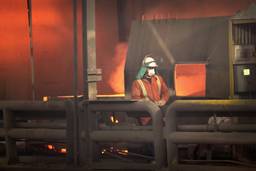America Is No Number 2: We Must Stop Chinese Currency Manipulation
Leo Gerard, United Steelworkers President
For 110 years America has reigned as the world’s number one manufacturing nation. Next year, China is expected to wrest that title from the United States.
Last year, the U.S. manufactured $1.7 trillion worth of goods; China fell second at $1.6 trillion. Next year, China is expected to edge out America with production worth $1.87 trillion.
America will be Number 2. And unlike the Dutch at the world cup, America is losing the crown it held for a century, not seeking a first-time anointment.
It doesn’t have to be this way. China’s manufacturing sector is using the equivalent of steroids to attain the title. It deliberately devalues its currency, an outlawed practice on international markets.
Devaluation means China’s exports are artificially cheap in the U.S. and American exports to China are falsely expensive. It’s no puny sum either. The discount for Chinese products sold in America is as much as 40 percent. – 40 cents on the dollar.
Allowing China to devalue its currency devalues American workers and businesses. Chinese currency manipulation is driving American manufacturers out of business and America workers into unemployment. For 110 years, American factories and workers have proved they can compete and win against all comers in the world. They can continue to do that if Congress places tariffs on Chinese exports to the U.S. or taxes them to compensate for the 40 percent price break the Chinese government arranges for its manufacturers.
Inaction means the U.S. government disrespects American workers and manufacturing in a way that the Chinese government does not. China deliberately manipulated its currency value to protect and preserve Chinese manufacturing jobs as the worldwide recession deepened in 2008.
Beginning in 2005, China had begun to allow the value of its currency to float up against the dollar on international currency markets. It rose about 7 percent a year, for a total of about 20 percent until 2008. Then, as the effects of the worst recession since the Great Depression hit China and tens of thousands of Chinese factory workers lost their jobs, China froze its currency’s value at 6.83 Yuan per dollar. At the same time, China continued to print Yuan for the sole purpose of buying dollars. In 2009, China bought about $450 billion-worth of dollars. This practice artificially raises the value of dollars and suppresses the value of Yuan.
Now China’s economy is booming again. Its exports in May increased by nearly 50 percent over a year earlier. Meantime, the American economy is stalled. The U.S. manufacturing sector has lost 2.1 million jobs – 16 percent of its total, since the recession began in December of 2007. Earlier this year, President Obama set a goal of doubling U.S. exports in five years, a feat that would pump up U.S. manufacturing and U.S. manufacturing jobs. But that goal will be impossible to reach if Congress doesn’t intervene to offset Chinese currency manipulation with tariffs.
In June, China announced that it would begin to permit the value of its currency to rise again. But since then, the value has floated up less than one percent – a trifling amount when it’s undervalued by 40 percent.
China injures its own workers with its currency manipulation as well. Undervaluing the Yuan suppresses their purchasing power. And it contributes to inflation in China, which further reduces workers’ buying power.
But it sustains Chinese manufacturing. It’s a predatory economic practice. China is feeding its economy by killing and devouring American manufacturing jobs.
Last week, in a long awaited report, the U.S. Treasury Department labeled China’s currency as undervalued. That’s fine, but it won’t save the U.S. from losing its title as world’s greatest manufacturer.
Diplomacy has failed to preserve American manufacturing and American jobs. China did what it felt was necessary to shelter its factories. Congress must flex some muscle to defend American manufacturers.
Legislation has been introduced in Congress that would impose tariffs on Chinese imports to offset the effect of the currency manipulation. It wouldn’t give American industry an unfair advantage; it would just take the steroids away from Chinese manufacturers.
The bills in both the House and Senate have bi-partisan support. This isn’t a liberal or conservative issue. This is a jobs bill that won’t raise the deficit.
Reps. Tim Ryan, D-Ohio, and Tim Murphy, R-Pa, co-sponsored the Currency Reform for Fair Trade Act, and Sens. Charles E. Schumer, D-NY, Debbie Stabenow, D-Mich., and Lindsey Graham, R-SC, sponsored the Currency Exchange Rate Oversight Reform Act.
Today is National Currency Manipulation Call-In Day. Tell your Senators and Congressman to stop the devaluation of U.S. manufacturing and U.S. workers. Tell them to pass these bills immediately or attach them to other legislation that will pass immediately. Sign this petition.
Tell them America is no Number 2.







